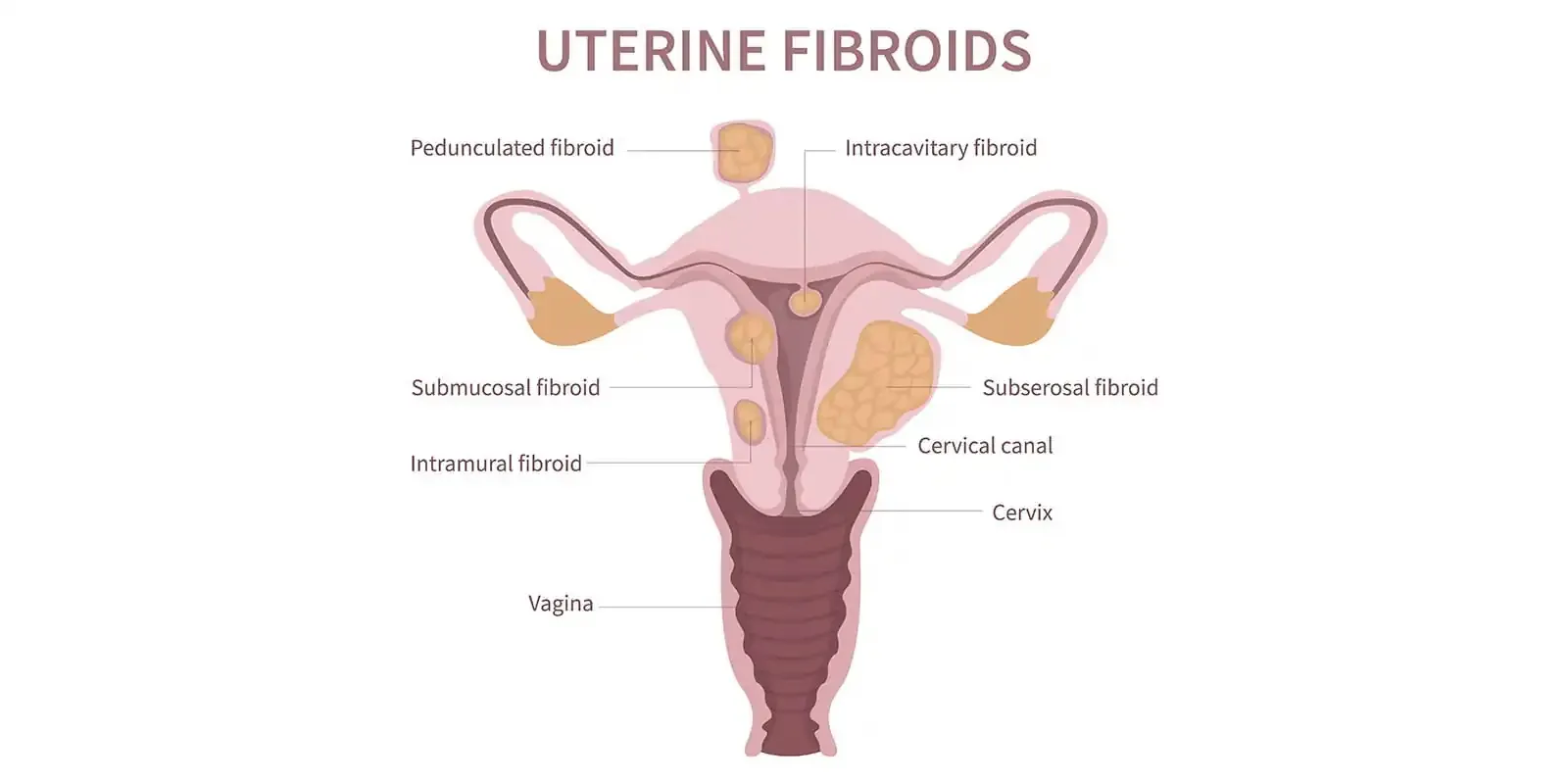Fibroids are tumors that grow in the uterus. They usually appear in women aged 30-50 and it is estimated that 2 out of 3 women of reproductive age will develop at least one fibroid in their lifetime. Fibroids are benign tumors and are not associated with the development of cancer.
They develop inside the uterus (submucosal fibroids), in the uterine wall (intramural fibroids), or on the outer surface (subserosal fibroids). They can be so small that they are not visible to the human eye or can be several centimetres in size, causing pressure on the uterus. Additionally, there may be only one fibroid or more, and it is not uncommon for the number and size of fibroids to change.
Fibroids mainly concern reproductive age. They usually start to develop from adolescence until about the age of 50, while they tend to shrink after menopause.
Fibroid Symptoms: When to go to the gynecologist?
About 2 out of 3 women do not know they have fibroids because they have no symptoms. Therefore, the diagnosis of fibroids is usually made accidentally during the annual gynecological check-up or during an ultrasound in pregnancy.
The symptoms caused by fibroids can be significant and mainly depend on their location and size. When symptoms exist, they may include:
- Period disorders
- Abdominal, pelvic, or back pain
- Constipation
- Difficulty urinating when pressing on the bladder
- Excessive bleeding during the period or bleeding between periods
- Excessive pain during the period
- Long duration of the period
- Infertility, when located in the uterine cavity
- Pregnancy issues
- Pain or discomfort during sexual intercourse
What are the causes of fibroids?
The exact causes of fibroid development have not been found, however, they seem to be related to hormonal changes, mainly in the levels of estrogen and progesterone, as well as cell abnormalities. Heredity plays a significant role, as it is often observed that one or more women in the same family have developed uterine fibroids.
Additionally, medical research to date has identified some factors that increase the chances of developing fibroids such as early onset of the period, obesity, lack of vitamin D, poor diet, and alcohol consumption. Finally, they appear more frequently in women who have not had a pregnancy.

When is there an indication for the removal of fibroids?
In some cases, uterine fibroids recede after menopause or delivery, so they may not require treatment. In other cases, medications are used, which shrink the fibroids and help control the symptoms.
Thus, the growth of fibroids does not necessarily require their surgical removal. However, there are some factors that force us to proceed with surgical treatment, such as:
- The sudden increase in their size
- When they cause symptoms such as significant blood loss (anaemia) and a feeling of heaviness in the abdomen
- The woman's age and her desire for childbearing
Laparoscopy: Treating fibroids with modern tools
The most important tool for treating fibroids is their surgical removal through laparoscopy. Laparoscopy is a minimally invasive surgery that helps us treat significant diseases of the abdominal organs and pelvis. In uterine fibroids, laparoscopy is done either for diagnosis or for their removal.
The future in the treatment of fibroids
Innovative therapeutic options, such as embolization of uterine arteries and focused ultrasound under magnetic resonance imaging, can give new hope to those suffering from fibroids, as they offer less invasive ways to manage the disease. Additionally, new drugs under development promise to treat the underlying causes of fibroids. These pioneering solutions offer more personalized options for managing fibroids and improving the quality of life.
How will we help you?
If you have symptoms of fibroids, suspect that you may have them, have already been diagnosed with them, or have undergone treatment without success, it is important to visit us. After recording your history and reviewing the tests you have already done, we may ask you for additional tests, such as magnetic resonance imaging, to confirm the diagnosis. If you have been recommended laparoscopy for fibroids, we will inform you about the entire process, from preparation, what to expect during it, to recovery. Additionally, we will answer all your questions before and after the surgery.
Fibroids are a condition that, although usually not noticeable and does not affect your daily life, can become the cause of serious health problems for you. Therefore, if you have fibroids, consult exclusively with specialized gynecologists who have been trained in laparoscopy.
When is there an indication for the removal of fibroids?
In some cases, uterine fibroids recede after menopause or delivery, so they may not require treatment. In other cases, medications are used, which shrink the fibroids and help control the symptoms.
Thus, the growth of fibroids does not necessarily require their surgical removal. However, there are some factors that force us to proceed with surgical treatment, such as:
- The sudden increase in their size
- When they cause symptoms such as significant blood loss (anaemia) and a feeling of heaviness in the abdomen
- The woman's age and her desire for childbearing
Laparoscopy: Treating fibroids with modern tools
The most important tool for treating fibroids is their surgical removal through laparoscopy. Laparoscopy is a minimally invasive surgery that helps us treat significant diseases of the abdominal organs and pelvis. In uterine fibroids, laparoscopy is done either for diagnosis or for their removal.
The future in the treatment of fibroids
Innovative therapeutic options, such as embolization of uterine arteries and focused ultrasound under magnetic resonance imaging, can give new hope to those suffering from fibroids, as they offer less invasive ways to manage the disease. Additionally, new drugs under development promise to treat the underlying causes of fibroids. These pioneering solutions offer more personalized options for managing fibroids and improving the quality of life.
How will we help you?
If you have symptoms of fibroids, suspect that you may have them, have already been diagnosed with them, or have undergone treatment without success, it is important to visit us. After recording your history and reviewing the tests you have already done, we may ask you for additional tests, such as magnetic resonance imaging, to confirm the diagnosis. If you have been recommended laparoscopy for fibroids, we will inform you about the entire process, from preparation, what to expect during it, to recovery. Additionally, we will answer all your questions before and after the surgery.
Fibroids are a condition that, although usually not noticeable and does not affect your daily life, can become the cause of serious health problems for you. Therefore, if you have fibroids, consult exclusively with specialized gynecologists who have been trained in laparoscopy.


